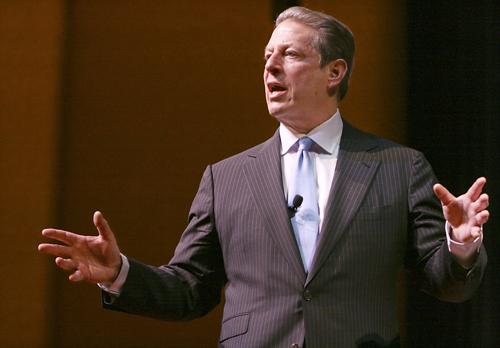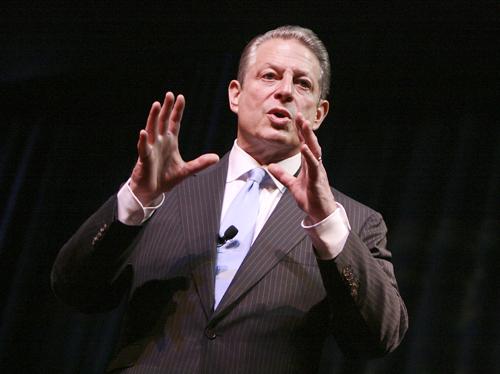
This post was written by Hatchet Reporter Michelle Brown.
Al Gore delivered a grim forecast for the future of the environment Thursday night in Lisner Auditorium, and stressed that without broad public support for clean, renewable energy sources, the next generation will live in “a world of destruction and decline.”
The former vice president– who appeared on campus to promote his new book, “Our Choice,” in front of a sold out crowd in Lisner – outlined what he believes to be the major causes of global warming, explained his solutions, but ultimately concluded that without broad public support and participation in sustainable initiatives, the crisis will only worsen.
Gore said it will be GW students and their peers at colleges nationwide who have the determination to solve the climate crisis, and encouraged the older generation to believe a global climate crisis exists, and to start taking measures to solve it.
“I want to encourage you to become part of the solution for this crisis,” Gore said to the audience, about 400 of whom were students. “This is not just an intellectual exercise, it’s not a game, it’s not a political issue. This is the moral issue of the present generation.”
Gore noted he was just 13 years old when President John F. Kennedy issued his challenge to land a person on the moon within 10 years. The U.S. faces a similar test today, Gore said, and young Americans will be the ones to rise to meet the challenge.
The day Americans landed on the moon, eight years after Kennedy issued the challenge, “a great cheer went up from the control room in Houston, Texas,” Gore said. “The average age of the systems engineer that day in Houston was 26, which means their average age when they heard JFK was 18.”
After asking who was determined to solve the climate crisis, Gore said, “Those people who raised their hands represent the future of this world. And your commitment in changing your role says you are a determined part to solve this crisis is the greatest hope we have going for us in this world today.”
Throughout the evening, Gore gave a brief overview of each of the chapters of his new book, explaining the causes and solutions to what he believes are the main causes of global warming, including carbon emissions, inefficient energy sources.
He described solar energy as a potential leader of the three cleaner energy solutions, which also include wind and geothermal energy.
Gore said that “more sunlight falls on the surface of our planet in one hour than the entire world’s energy consumption in one year,” and that scientists have found ways to capture this sunlight and turn it into energy. Yet Gore said the price of the technology that scientists are creating “depends on the market and their demand,” and stressed the need for consumers to demand that these technologies become more accessible.

Ultimately, Gore left his audience with two scenarios. He said that world leaders and the older generation can ignore the problem, and shrug it off as unimportant. Or, he said, these same people can accept reality, and begin to make the necessary changes to fix the environmental emergency.
“Not too many years from now, the next generation will look back at what we did or did not do in these first years of the twenty-first century,” Gore said. “If they see around them a world of destruction and decline as the scientists predicted would occur and we didn’t solve this climate crisis, they would be justified in looking back at us and asking, ‘What were you thinking?’ ‘Why did you do nothing?’ ‘Did you hear the scientists?’ ‘Did you notice the north polar ice caps melting right before your eyes?’ ‘Did you care?!’ ”
He continued, “Or they will ask a second question, the one I would prefer them to ask. If they look around them and see a world in renewal, with millions of good, new jobs building windmills, solar outlets, Smartgrids, and retro-fitting homes, and less dependent on foreign oil and with a sense of purpose and solution of the problems that this world needs to have solved, they will look at us and say, ‘how did you find the moral courage to rise up and solve the crisis that so many people said was impossible to solve?’”
Gore left the audience with one final charge.
“We’ve got everything we need to do it, with the possible exception of political will,” Gore said. “But ladies and gentlemen, in the United States of America, as these young people are demonstrating, political will is a renewable resource.”
Students at the event said Gore’s charge to the audience was moving.
“I think the end was the best part of the presentation,” said junior Leire Ariz. “Young people and students, we need someone to encourage us. Its good to focus on the positive things.”
Freshman Jason Katz agreed. He said he found Gore’s comparison of putting a man on the moon to fixing the problems facing the environment was inspiring.
“His example of how they thought it was impossible to get a man on the moon, and then ten- no, eight- years later, we did it, was a good point,” Katz said. “If we put our mind to [solving this problem], we can get it done.”



